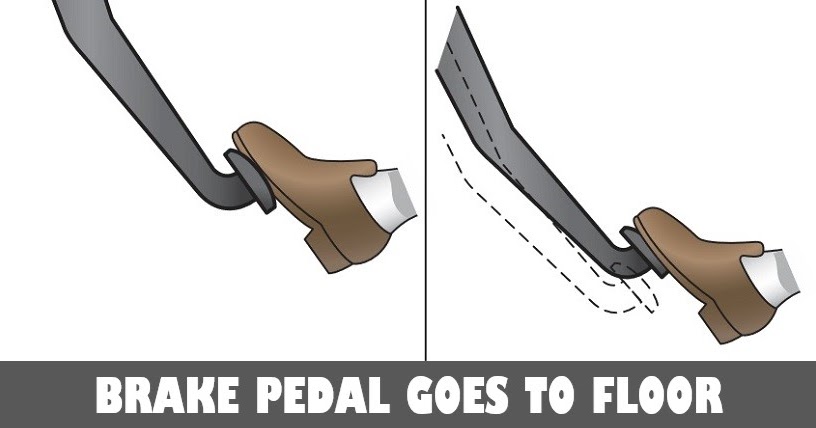The unsettling feeling of pressing the brake pedal and feeling nothing, realizing your car won’t stop, is a terrifying scenario that no driver wants to experience. It’s a nightmare scenario that can quickly turn into a disaster, leaving you with a sinking feeling in your stomach and a sense of panic. This article dives into the reasons behind this potentially life-threatening issue, providing clear explanations, expert tips, and actionable steps to ensure your safety.

Image: www.cartechhome.com
Imagine this: you’re cruising down a familiar road, feeling confident behind the wheel, when a reckless driver cuts in front of you. Instinctively, you slam on your brakes, but the pedal goes all the way to the floor, and your car keeps moving. Fear grips you as the seconds stretch out into a terrifying eternity. This is a classic symptom of brake failure, and understanding why this happens is crucial for every driver.
The Science Behind the Brake Failure: Deciphering the Problem
A car’s braking system is a complex network of components working together to control your vehicle’s speed. It relies on friction to transform kinetic energy into heat, bringing your car to a stop. When you press the brake pedal, the force is transmitted through hydraulic lines to brake calipers, which squeeze brake pads against rotating discs or drums. This friction then slows the wheels and ultimately your car.
Common Culprits of Brake Failure: Unmasking the Problem
When your brakes fail to engage, it’s usually due to one of several common issues:
- Hydraulic System Failure: This is the most frequent cause, and it involves a leak in the brake fluid lines or damaged brake master cylinder. Brake fluid plays a vital role in transmitting pressure, and without it, the brake calipers won’t receive the necessary force to engage the pads against the rotors.
- Worn or Damaged Brake Pads: Excessive wear on the brake pads can lead to a reduced braking area, making your brakes less effective. Additionally, damaged brake pads could result in a faulty response to your braking input.
- Faulty Brake Calipers: These are responsible for squeezing the brake pads against the rotors. If they malfunction, they may not apply the necessary pressure, leading to a reduced braking effect.
- Air in the Brake Lines: Air trapped in the brake lines can compress, making it difficult for the brake fluid to transmit the necessary pressure to the calipers.
- Frozen Brake Lines: Extreme cold temperatures can cause brake lines to freeze, hindering the flow of brake fluid and causing brake failure.
Recognizing the Warning Signs: Preventing a Disaster
The good news is that there are often warning signs that something is amiss with your brakes. A little attention to these signals can save you from a disastrous situation:
- Spongy Brake Pedal: If your brake pedal feels soft or sinks to the floor, it’s a clear indication of a problem with the brake system, often a leak or air in the lines.
- High-pitched Squealing Sound: This is usually the result of worn brake pads that are close to needing replacement.
- Grinding Sound: If you hear a grinding or scraping sound when braking, it’s a sign that your brake pads are completely worn down and potentially damaging the rotors or drums.
- Vehicle Pulling to One Side: This can be caused by an issue with one or more brake calipers, indicating a potential problem that needs immediate attention.
- Unusual Brake Fluid Level: A sudden drop in brake fluid level is a serious warning sign of a leak in the brake system.

Image: www.bestpowerstroke.com
Expert Tips for Staying Safe: Taking Control of the Situation
If you encounter a situation where your brakes don’t work, the following steps can help you control the situation and minimize the risk of an accident.
- Pump the Brake Pedal: If you have some brake function, try pumping the pedal aggressively. This may build up enough pressure to slow the vehicle, giving you time to pull over.
- Use the Emergency Brake: If the brake pedal isn’t responding, try using the emergency brake or parking brake. However, use it with caution as it may only work to slow or stop your vehicle at relatively slow speeds.
- Downshift to Lower Gears: Downshifting to lower gears can help engine braking slow your vehicle.
- Look for a Safe Place: Search for a safe area to pull over, such as a parking lot or a side street.
- Avoid Sudden Maneuvers: Steer clear of abrupt turns or lane changes, as these can worsen the situation and lead to a loss of control.
Beyond the Basics: Ensuring Your Safety and Peace of Mind
Preventing brake failure is a proactive approach that involves regular vehicle maintenance and inspections. Here are some essential steps:
- Regular Brake Inspections: Have your brakes inspected by a qualified mechanic at least once a year, or more often if you notice any warning signs.
- Proper Brake Fluid Maintenance: Brake fluid can absorb moisture over time, which can impair its effectiveness. Have the fluid flushed and replaced every two years or as recommended by your vehicle manufacturer.
- Maintain Appropriate Tire Pressure: Underinflated tires can reduce the effectiveness of your brakes.
- Be Aware of Your Driving Habits: Aggressive braking, driving on uneven roads, or overloading your vehicle can put extra strain on your brakes, leading to premature wear and tear.
Brakes Don T Work Until Pedal Goes To Floor
Conclusion: Taking Ownership of Your Safety
Experiencing brake failure can be a terrifying experience. However, understanding the causes, recognizing the warning signs, and following the tips outlined above can empower you to stay safe and prevent a potentially disastrous situation.
Make sure your brakes are in top shape. It’s a crucial investment in your safety.

:max_bytes(150000):strip_icc()/OrangeGloEverydayHardwoodFloorCleaner22oz-5a95a4dd04d1cf0037cbd59c.jpeg?w=740&resize=740,414&ssl=1)




